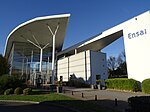Catastrophe du Boël

The catastrophe du Boël (disaster of Boël) was a landslide that occurred on June 6, 1884, in a quarry at a place named Le Boël in Bruz, Ille-et-Vilaine, in the west of France. The landslide killed eight people including two children. Groundwater that weakened the cliff and damage caused by explosives used to remove red shale (found as a construction material in the local churches) from the quarry were the principal causes of the accident. The search to recover the bodies took five days. At the time, the event left its mark, probably because of the death of the children and because it impacted different social classes. Editors of several newspapers from Rennes collaborated and sold a magazine at 50 cents apiece to benefit the victims. Donation campaigns were also carried out by the local press.
Excerpt from the Wikipedia article Catastrophe du Boël (License: CC BY-SA 3.0, Authors, Images).Catastrophe du Boël
D 131, Redon
Geographical coordinates (GPS) Address Nearby Places Show on map
Geographical coordinates (GPS)
| Latitude | Longitude |
|---|---|
| N 47.992777777778 ° | E -1.7541666666667 ° |
Address
Moulin du Boël
D 131
35580 Redon
Brittany, France
Open on Google Maps









